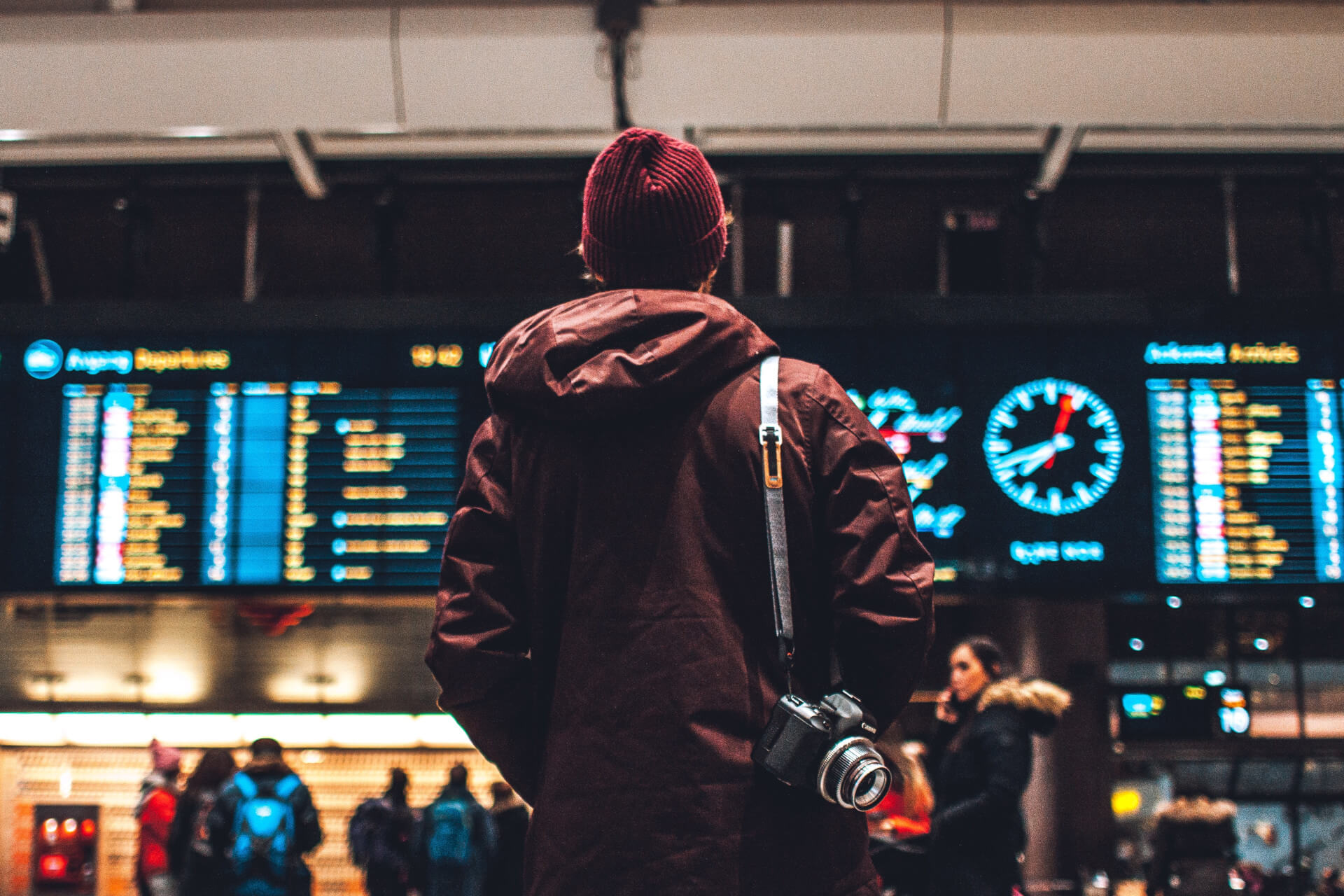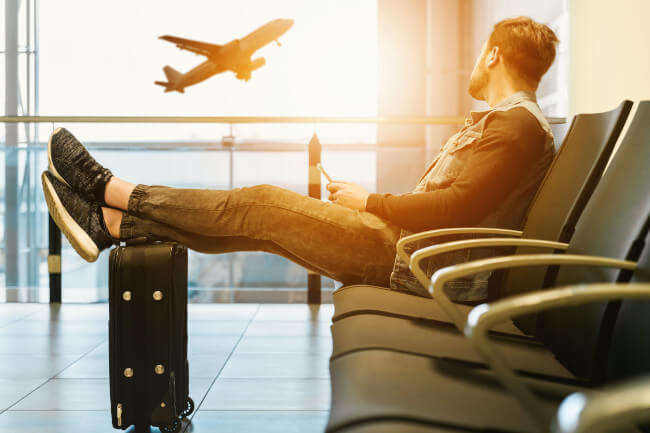
Checking-in, dropping off luggage, going through the security checkpoint, boarding…, the course of a traveler can often lead to stress and worry. A largely amplified phenomenon for travelers with disabilities who struggle to move around and find their bearings in such huge places. Millions of people pass through airports every year. How is accessibility deployed within airports? What measures can be implemented to enable the 61 million Americans with disabilities to safely travel?
Indeed, when we travel, a lot of us tend to be stressed because of all the steps to follow and things not to forget. This feeling can be increased for a person with disabilities who needs precise information and a personalized care according to their profile.
Let’s make a quick scan of the progress of airport accessibility in the United States!
How to safely travel?
The Americans with Disabilities Act of 1990 (ADA) aims at prohibiting discrimination towards people with disabilities and at implementing accessibility measures in public accommodations. Thus, every American airport has to follow rules and regulations to make sure that travelers with disabilities can easily have access to the same services and advantages as other travelers. Moreover, the Air Carrier Access Act of 1986 focuses on discrimination on airlines. They have to accomodate the needs of people with disabilities aboard aircraft. From any airport in the US, travelers with disabilities are provided with the same assistance services such as:
⊗ When purchasing their flight tickets, travelers can indicate if they need assistance;
⊗ The Transportation Security Administration (TSA) helpline helps travelers with disabilities to go through security checkpoints;
⊗ Pet relief areas for furry companions. Even they have their own private restrooms;
⊗ Airlines provide assistance throughout the whole trip (boarding, deplaning and making connections).
Even when travelers prepare their journey at home, they can easily know what type of assistance the airport provides since airports all have a dedicated page on assistance service on their website. Plus all airport websites have to be accessible to enable visually impaired people to easily get the necessary information. Such is the case with Denver International Airport (DEN) that lists all its accessibility services and details specific subjects (the location of its accessible parking spaces for example). A map of the airport and its terminals is available on the website but also on the airport app. Smartphones are indeed a vital tool for people with disabilities enabling them to gain more autonomy.
However, assistance services constitute a huge cost for airports. People with reduced mobility and people with disabilities more and more request these services that have difficulties to meet demand. Customer care representatives aren’t always available and some may not have received the appropriate training. If airports could focus on other accessibility measures, this could hugely relieve assistance services and provide more autonomy to travelers with disabilities. Indeed, they wouldn’t have to depend on assistance services as much. Plus there wouldn’t be as many complaints as there are now.
Following the ADA, travelers who didn’t have access to any services provided by airports can directly file a complaint online. Each airport website gives this opportunity to passengers, for example the Los Angeles Airport (LAX).
It’s to be noted that some people don’t want to use assistance services and prefer to travel by themselves or accompanied by a relative to help them through all the steps in their trip.
An efficient signage system is key to answer their needs and can easily be implemented to equip such a complex place like an airport:
⊗ Audio beacons that indicate to visually impaired people the location of different strategic points of interest (entrances, counters, restrooms…);
⊗ Braille signs;
⊗ Display screens with bigger letters and contrasting colors;
⊗ Pictograms with geometric shapes;
⊗ Guide paths for orientation;
⊗ An indoor wayfinding app like Evelity that guides from point A to point B people with disabilities (everything can be located: check-in counters and shops entrances).
Installing a clear and understandable signage system helps travelers with disabilities (blind or visually impaired people but also people with intellectual disabilities) to get their bearings, just like any traveler.
LAX already breaks ground thanks to the Aira app available on its site. It helps passengers to find their way on the premises. A lot of airports lean on technology to assist travelers.
Easily accessing check-in counters and boarding gates makes our experience better. For travelers in wheelchairs, that means lowered counters, wide-access doors and security lanes. For them and other travelers with a lot of luggage, all airports have elevators, escalators and ramps. With wide ramps, one of the principles of universal design, people can easily and rapidly move around in the airport. Embracing universal design, airports create a better and more accessible environment to facilitate the trip of all their passengers. The restroom stalls of Minneapolis-Saint Paul International Airport (MSP) have doors that swing out and side grab rails. Plus some space for those who have a carry-on suitcase.
A trained and receptive staff
Since every American airport provides its passengers with disabilities with assistance services, a trained and open staff is key to make sure a trip is going according to plan. But this proves to be difficult to achieve seeing that airports are faced with a constant turnover, plaguing the efficiency of the services. Continually emphasizing the importance of an adequate training program is critical to ensure that travelers with disabilities are properly taken care of.
Greeting with a smile, being informative, available, having empathy and adapting to the persons according to their profile and their needs all are essential qualities that make a good customer care representative. A true accessibility service that’s focused on helping others.
For travelers with a hearing impairment, a visual paging system can help them to stay informed concerning their flight since they can’t rely on audio messages. The Dallas/Fort Worth International Airport (DFW) uses both a visual and an audible paging system to convey real-time information to passengers. At check-in counters, hearing impaired travelers still can interact with the staff thanks to sound amplifying devices. Besides, several apps can also help travelers with an hearing impairment to communicate with staff. For example Ava which can be downloaded on both the traveler’s smartphone and the flight attendant’s in order to facilitate their conversation. Even shops can be equipped with sound amplifying devices, induction loops, or use Ava or any other app, providing a comprehensive and efficient service to all their clients. Thus airport accessibility happens at different levels.
How to go to the airport?
The first step is going to the airport. By car? By train? By bus? What’s the best way to go to the airport for people with disabilities?
A person with reduced mobility who uses their personal vehicle can park at different areas since parking airports are all equipped with PRM spaces. A true asset to get more independence! The John F. Kennedy International Airport (JFK) even makes its passengers with reduced mobility who use PRM spaces profit from discounts.
The Chicago O’Hare International Airport (OHD) can be reached by public transportation in different ways. Indeed, from downtown, passengers can take the CTA Blue Line train. The station within the airport is equipped with an elevator making it easy for people with reduced mobility to go to or leave the platform. Although not all CTA stations are accessible, its buses and trains have: spaces designated for people in wheelchairs, buses with ramps or that can kneel to the curb. Thanks to a station directly connected to the airport, passengers can gain more autonomy. They don’t have to depend on a taxi or on a friend to drop them off. Using a reliable system that adapts to people with disabilities, regardless of their profile, helps travelers feel safe and more comfortable in their trip. In a previous article, we saw that people with disabilities needed to count on an accessible subway. Travel without feeling any unnecessary stress is quite the luxury.
It’s obvious that airport accessibility is progressing. The implementation of the ADA ensuring travelers with disabilities have access to the same services as other travelers has permitted to move things forward. Even if nowadays it’s easier to travel, airports still have to continue to listen to all its passengers. Other measures can make people with disabilities have a better experience during their travels. A constant renewal is necessary to truly answer the needs of everybody.
media

Millions of people pass through airports every year. How is accessibility deployed within airports?
writer

Carole Martinez
Content Manager
stay updated
Get the latest news about accessibility and the Smart City.
other articles for you

Open Data Is Key to Fostering Universal Accessibility
Open data represents an opportunity for cities to reach universal accessibility. It shows the missing links of the mobility chain.
Our Audio Beacons Guide the Blind and Visually Impaired at the Helsinki Subway
The Helsinky subway improved their audio signage system by installing on demand and remotely activated audio beacons.
7 Good Reasons to Install Audio Beacons at Your Public Transport Network
Audio beacons are an efficient way to provide more autonomy to blind and visually impaired people. They can easily use public transport.

Will Remote Activation Become the Norm for Accessible Pedestrian Signals?
More and more cities like New York have been exploring remote activation to trigger accessible pedestrian signals.
share our article!
more articles

Disability Statistics in the US: Looking Beyond Figures for an Accessible and Inclusive Society
Disability Statistics in the US: Looking Beyond Figures for an Accessible and Inclusive Society Around 61 million adults in the United States live with a disability. Diving into disability statistics in the US will help us know exactly who is concerned and what...
Our Audio Beacons Guide the Blind and Visually Impaired at the Helsinki Subway
Our Audio Beacons Guide the Blind and Visually Impaired at the Helsinki SubwayOur audio beacons equip the new line of the Helsinki subway in Finland. They help blind and visually impaired people locate the points of interest of a station. For users with visual...

Will Remote Activation Become the Norm for Accessible Pedestrian Signals?
Will Remote Activation Become the Norm for Accessible Pedestrian Signals?Without pushbutton, there are no accessible pedestrian signals. That’s how APS work in the U.S. But more and more cities have been exploring remote activation like New York City. The Department...

Hearing Impaired People: a Multitude of Profiles for Different Needs
Hearing Impaired People: a Multitude of Profiles for Different Needs Did you know that hearing impaired people have several profiles and that the way they identify themselves is important? You may be familiar with deaf and hard of hearing people but for each of...
NEVER miss the latest news about the Smart City.
Sign up now for our newsletter.
Unsubscribe in one click. The information collected is confidential and kept safe.
powered by okeenea
The French leading company
on the accessibility market.
For more than 25 years, we have been developing architectural access solutions for buildings and streets. Everyday, we rethink today’s cities to transform them in smart cities accessible to everyone.
By creating solutions ever more tailored to the needs of people with disabilities, we push the limits, constantly improve the urban life and make the cities more enjoyable for the growing majority.


